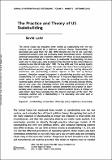|
Reseña:
|
The United States has employed three models of statebuilding over the last century, each animated by a different political theory. Statebuilding 1.0, developed and used from the late 1890s through the end of the Cold War, emphasized building loyal and politically stable subordinate states. Privileging American geopolitical and economic interests over those of local populations, the model was premised on the theory of realpolitik. Statebuilding 2.0 arose under and, in many ways, came to characterize attempts by the United States to construct a New World Order after 1990. The key shift was from seeking loyalty to building legitimate states. Under this model, the United States attempted to build broad-based popular support for nascent states by creating democratic institutions and spearheading economic reforms. In this ‘end of history’ moment, liberalism reigned triumphant in statebuilding practice and theory. Statebuilding 3.0 is now being ‘field-tested’ in Iraq and Afghanistan. This new model seeks to build legitimacy for new states by providing security and essential public services to their populations. It rests on social contract theory, and its core tenet that legitimacy follows from providing effectively for the basic needs of citizens. Successive sections summarize the practice of statebuilding under each model and discuss its implicit political theory. A critique of each model then flows naturally into the practice and logic of the next. The conclusion outlines why a statebuilding 3.1 is necessary, and what such a strategy might entail. |

